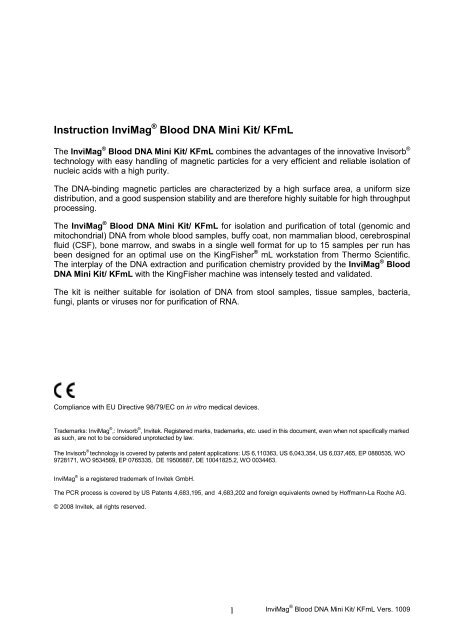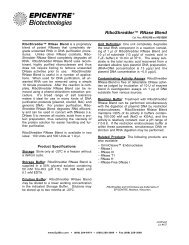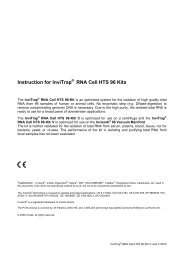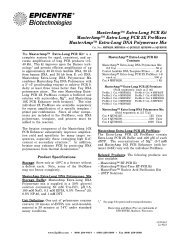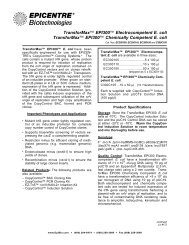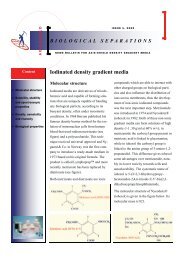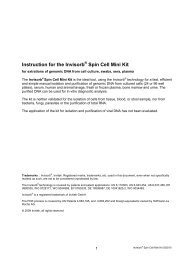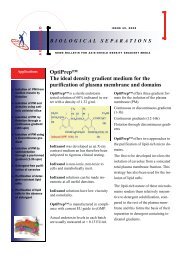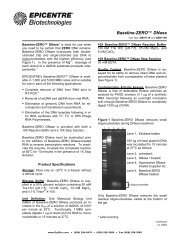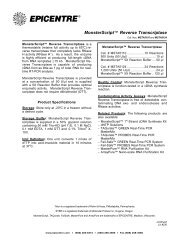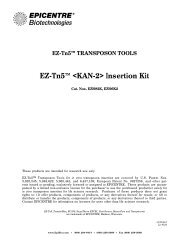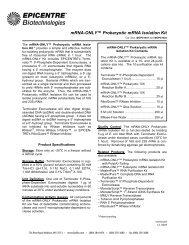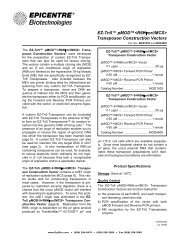Instruction InviMag® Blood DNA Mini Kit/ KFmL
Instruction InviMag® Blood DNA Mini Kit/ KFmL
Instruction InviMag® Blood DNA Mini Kit/ KFmL
You also want an ePaper? Increase the reach of your titles
YUMPU automatically turns print PDFs into web optimized ePapers that Google loves.
<strong>Instruction</strong> InviMag ® <strong>Blood</strong> <strong>DNA</strong> <strong>Mini</strong> <strong>Kit</strong>/ <strong>KFmL</strong><br />
The InviMag ® <strong>Blood</strong> <strong>DNA</strong> <strong>Mini</strong> <strong>Kit</strong>/ <strong>KFmL</strong> combines the advantages of the innovative Invisorb ®<br />
technology with easy handling of magnetic particles for a very efficient and reliable isolation of<br />
nucleic acids with a high purity.<br />
The <strong>DNA</strong>-binding magnetic particles are characterized by a high surface area, a uniform size<br />
distribution, and a good suspension stability and are therefore highly suitable for high throughput<br />
processing.<br />
The InviMag ® <strong>Blood</strong> <strong>DNA</strong> <strong>Mini</strong> <strong>Kit</strong>/ <strong>KFmL</strong> for isolation and purification of total (genomic and<br />
mitochondrial) <strong>DNA</strong> from whole blood samples, buffy coat, non mammalian blood, cerebrospinal<br />
fluid (CSF), bone marrow, and swabs in a single well format for up to 15 samples per run has<br />
been designed for an optimal use on the KingFisher ® mL workstation from Thermo Scientific.<br />
The interplay of the <strong>DNA</strong> extraction and purification chemistry provided by the InviMag ® <strong>Blood</strong><br />
<strong>DNA</strong> <strong>Mini</strong> <strong>Kit</strong>/ <strong>KFmL</strong> with the KingFisher machine was intensely tested and validated.<br />
The kit is neither suitable for isolation of <strong>DNA</strong> from stool samples, tissue samples, bacteria,<br />
fungi, plants or viruses nor for purification of RNA.<br />
Compliance with EU Directive 98/79/EC on in vitro medical devices.<br />
Trademarks: InviMag ® ,: Invisorb ® , Invitek. Registered marks, trademarks, etc. used in this document, even when not specifically marked<br />
as such, are not to be considered unprotected by law.<br />
The Invisorb ® technology is covered by patents and patent applications: US 6,110363, US 6,043,354, US 6,037,465, EP 0880535, WO<br />
9728171, WO 9534569, EP 0765335, DE 19506887, DE 10041825.2, WO 0034463.<br />
InviMag ® is a registered trademark of Invitek GmbH.<br />
The PCR process is covered by US Patents 4,683,195, and 4,683,202 and foreign equivalents owned by Hoffmann-La Roche AG.<br />
© 2008 Invitek, all rights reserved.<br />
1<br />
InviMag ® <strong>Blood</strong> <strong>DNA</strong> <strong>Mini</strong> <strong>Kit</strong>/ <strong>KFmL</strong> Vers. 1009
Contents<br />
<strong>Kit</strong> contents of InviMag ® <strong>Blood</strong> <strong>DNA</strong> <strong>Mini</strong> <strong>Kit</strong>/ <strong>KFmL</strong> 4<br />
Symbols 5<br />
Quality control 5<br />
Intended use 6<br />
Product use limitation 6<br />
Safety information 7<br />
Product characteristics of the InviMag ® <strong>Blood</strong> <strong>DNA</strong> <strong>Mini</strong> <strong>Kit</strong>/ <strong>KFmL</strong> 8<br />
Principle and procedure 9<br />
Yield and quality of genomic <strong>DNA</strong> 9<br />
Important notes 10<br />
Important points before starting a protocol 10<br />
Preparing reagents and buffers 10<br />
Reagents and equipment to be supplied by user 10<br />
Scheme 11<br />
Protocol 1: Isolation of genomic <strong>DNA</strong> from up to 200 Cl of whole blood or<br />
1 – 30 Cl buffy coat 12<br />
Protocol 2: Isolation of genomic <strong>DNA</strong> from up to 25 Cl of non mammalian blood 14<br />
Protocol 3: Isolation of genomic <strong>DNA</strong> from CSF and bone marrow 15<br />
Protocol 4: Isolation of genomic <strong>DNA</strong> from swabs or rinsed liquid from swabs 16<br />
For self programming of the KingFisher mL system<br />
(program “ InviMAG_ <strong>Blood</strong>_Lys30”) 17<br />
For self programming of the KingFisher mL system<br />
(program “InviMAG_<strong>Blood</strong>2_mL”) 18<br />
Troubleshooting 19<br />
Appendix 20<br />
General notes on handling <strong>DNA</strong> 21<br />
Order information 22<br />
Invitek distributor 23<br />
2<br />
InviMag ® <strong>Blood</strong> <strong>DNA</strong> <strong>Mini</strong> <strong>Kit</strong>/ <strong>KFmL</strong> Vers. 1009
<strong>Kit</strong> contents of InviMag ® <strong>Blood</strong> <strong>DNA</strong> <strong>Mini</strong> <strong>Kit</strong>/ <strong>KFmL</strong><br />
Store the SNAP Solution at 4 °C!<br />
Store lyophilized Proteinase K at 2 - 8 °C!<br />
Store dissolved Proteinase K at –20 °C!<br />
Store all other kit components at room temperature (RT)!<br />
15 extractions 75 extractions 150 extractions 300extractions<br />
Catalogue No. 2431110100 2431110200 2431110300 2431110400<br />
Lysis Buffer A 5 ml 20 ml 40 ml 70 ml<br />
Proteinase K<br />
(working solution)<br />
for 0.5 ml<br />
working solution<br />
for 2 ml<br />
working solution<br />
for 2 x 2 ml<br />
working solution<br />
for 7 ml<br />
working solution<br />
SNAP Solution 0.5 ml 2 x 1 ml 3 x 1.2 ml 6 x 1.2 ml<br />
Binding Buffer B6 8 ml 40 ml 70 ml 140 ml<br />
Wash Buffer I<br />
7.5 ml<br />
(final volume 15 ml)<br />
2 x 30 ml<br />
(final volume 2 x 60 ml)<br />
80 ml<br />
(final volume 160 ml)<br />
2 x 80 ml<br />
(final volume 2 x 160 ml)<br />
Wash Buffer II<br />
18 ml<br />
(final volume 60 ml)<br />
45 ml<br />
(final volume 150 ml)<br />
2 x 45 ml<br />
(final volume 2 x 150 ml)<br />
3 x 60 ml<br />
(final volume 3 x 200 ml)<br />
Elution Buffer D 2 x 2 ml 20 ml 40 ml 70 ml<br />
KingFisher mL Tip Combs 3 15 30 60<br />
KingFisher mL Tube Strips 15 5 x 15 150 300<br />
1.5 ml Receiver Tubes 15 5 x 15 3 x 50 6 x 50<br />
Manual 1 1 1 1<br />
Initial steps<br />
Dilute Proteinase K<br />
by addition of 0,5 ml<br />
ddH 2O, mix<br />
thoroughly and store<br />
like described below!<br />
Dilute Proteinase K<br />
by addition of 2 ml<br />
ddH 2O, mix<br />
thoroughly and store<br />
like described below!<br />
Dilute Proteinase K<br />
by addition of each 2<br />
ml ddH 2O, mix<br />
thoroughly and store<br />
like described below!<br />
Dilute Proteinase K<br />
by addition of 7 ml<br />
ddH 2O, mix<br />
thoroughly and store<br />
like described below!<br />
Add 7.5 ml of 96 -<br />
100 % ethanol to the<br />
bottle Wash Buffer<br />
I, mix thoroughly<br />
and always keep the<br />
bottle firmly closed!<br />
Add 30 ml of 96 - 100<br />
% ethanol to the<br />
bottle Wash Buffer I,<br />
mix thoroughly and<br />
always keep the<br />
bottle firmly closed!<br />
Add 80 ml of 96 - 100<br />
% ethanol to the<br />
bottle Wash Buffer<br />
I, mix thoroughly and<br />
always keep the<br />
bottle firmly closed!<br />
Add 80 ml of 96 - 100<br />
% ethanol to each<br />
bottle Wash Buffer I,<br />
mix thoroughly and<br />
always keep the<br />
bottle firmly closed!<br />
Add 42 ml of 96 -<br />
100 % ethanol to the<br />
bottle Wash Buffer<br />
II, mix thoroughly<br />
and always keep the<br />
bottle firmly closed!<br />
Add 105 ml of 96 -<br />
100 % ethanol to the<br />
bottle Wash Buffer II,<br />
mix thoroughly and<br />
always keep the<br />
bottle firmly closed!<br />
Add 105 ml of 96 -<br />
100 % ethanol to<br />
each bottle Wash<br />
Buffer II, mix<br />
thoroughly and<br />
always keep the<br />
bottle firmly closed!<br />
Add 140 ml of 96 -<br />
100 % ethanol to<br />
each bottle Wash<br />
Buffer II, mix<br />
thoroughly and<br />
always keep the<br />
bottle firmly closed!<br />
3<br />
InviMag ® <strong>Blood</strong> <strong>DNA</strong> <strong>Mini</strong> <strong>Kit</strong>/ <strong>KFmL</strong> Vers. 1009
Symbols<br />
manufacturer<br />
lot number<br />
catalogue number<br />
date of manufacture<br />
expiry date<br />
consult operating instructions<br />
temperature limitation<br />
do not reuse<br />
Storage<br />
All buffers and kit contents of the InviMag ® <strong>Blood</strong> <strong>DNA</strong> <strong>Mini</strong> <strong>Kit</strong>/ <strong>KFmL</strong>, except Proteinase K and<br />
SNAP Solution should be stored at room temperature and are stable for at least 12 months<br />
under these conditions.<br />
Room temperature (RT) is defined as range from 15 - 30°C.<br />
Proteinase K: Lyophilized Proteinase K should be stored at 2 - 8°C. Dissolved Proteinase K<br />
must be stored at – 20°C. Dividing the Proteinase K into aliquots and storage at – 20°C is<br />
recommended.<br />
SNAP Solution: SNAP Solution should be stored at 4 °C.<br />
Wash Buffers: Wash Buffers charged with ethanol should be stored at room temperature and<br />
should be appropriate sealed. If there are any precipitates within the provided solutions solve<br />
these precipitates by careful warming up to room temperature (up to 30°C).<br />
Quality control<br />
Invitek guarantees the correct function of the InviMag ® <strong>Blood</strong> <strong>DNA</strong> <strong>Mini</strong> <strong>Kit</strong>/ <strong>KFmL</strong> for<br />
applications as described in the manual. In accordance with Invitek’s certified QM-System each<br />
component of the InviMag ® <strong>Blood</strong> <strong>DNA</strong> <strong>Mini</strong> <strong>Kit</strong>/ <strong>KFmL</strong> was tested against predetermined<br />
specifications to ensure consistent product quality.<br />
All products sold by Invitek are subjected to extensive quality control procedures according to<br />
ISO 9001-2000 and are warranted to perform as described when used correctly. Any problems<br />
should be reported immediately.<br />
If you have any questions or problems regarding any aspects of InviMag ® <strong>Blood</strong> <strong>DNA</strong> <strong>Mini</strong> <strong>Kit</strong>/<br />
<strong>KFmL</strong> or other Invitek products, please do not hesitate to contact us.<br />
For technical support or further information please contact:<br />
from Germany +49-(0)30-9489-2901/ 2910<br />
from abroad +49-(0)30-9489-2907<br />
or contact your local distributor (see page 23).<br />
4<br />
InviMag ® <strong>Blood</strong> <strong>DNA</strong> <strong>Mini</strong> <strong>Kit</strong>/ <strong>KFmL</strong> Vers. 1009
Intended use<br />
The InviMag ® <strong>Blood</strong> <strong>DNA</strong> <strong>Mini</strong> <strong>Kit</strong>/ <strong>KFmL</strong> has been designed for semi automated extraction<br />
and purification of total (genomic and mitochondrial) <strong>DNA</strong> from up to 15 whole blood or blood<br />
related samples per run using magnetic beads and the KingFisher mL. The nucleic acid isolation<br />
protocol is suitable for routinely walk away automated preparation of <strong>DNA</strong> from fresh or frozen<br />
whole blood sample, buffy coat, non mammalian blood, cerebrospinal fluid (CSF), bone marrow,<br />
and swabs. For reproducible and high yields an appropriate sample storage is essential (see<br />
“Sampling and storage of the starting material”, page 9). Common blood collection tubes (not<br />
provided) and anticoagulants (EDTA, citrate, not heparin) can be used to assemble a set of<br />
blood samples. All utilities (reagents and plasticware) necessary for preparation of total <strong>DNA</strong> are<br />
provided by the InviMag ® <strong>Blood</strong> <strong>DNA</strong> <strong>Mini</strong> <strong>Kit</strong>/ <strong>KFmL</strong> in different package sizes.<br />
The procedure of the InviMag ® <strong>Blood</strong> <strong>DNA</strong> <strong>Mini</strong> <strong>Kit</strong>/ <strong>KFmL</strong> has been optimized for the isolation<br />
of total <strong>DNA</strong> from up to 200 Cl starting material. For samples of a smaller volume than 200 Cl<br />
please adjust to a total sample volume of 200 Cl with 1 x PBS prior to the start of an isolation<br />
protocol.<br />
Any diagnostic results generated using the sample preparation procedure in conjunction with<br />
any downstream diagnostic assays should be interpreted with regard to other clinical or<br />
laboratory finding.<br />
The product is intented for use by professional users such as technicians, physicians and<br />
biologists trained in molecular biological techniques. It is designed to be used with any<br />
downstream application employing enzymatic amplification or other enzymatic modification of<br />
<strong>DNA</strong> followed by signal detection or amplification. Any diagnostic results generated using the<br />
sample preparation procedure in conjunction with any downstream diagnostic assay should be<br />
interpreted with regard to other clinical or laboratory findings.<br />
To minimize irregularities in diagnostic results, adequate controls for downstream applications<br />
should be used.<br />
Product use limitation<br />
The kit is neither validated for the isolation of <strong>DNA</strong> from stool samples, tissue, bacteria, fungi or<br />
viruses, nor for isolation and purification of RNA..<br />
The included chemicals are for single use only.<br />
When differing the starting material or the flow trace, no guarantee in operability is issued.<br />
The user is responsible to validate the performance of the Invitek kits for any particular use,<br />
since the performance characteristics of our kits have not been validated for any specific<br />
application. Invitek kits may be used in clinical diagnostic laboratory systems after the laboratory<br />
has validated the complete diagnostic system as required by CLIA’ 88 regulations in the U.S. or<br />
equivalents in other countries.<br />
All products sold by Invitek are subjected to extensive quality control procedures (according to<br />
EN ISO 9001-2000 and EN ISO 13485-2003) and are warranted to perform as described when<br />
used correctly. Any problems should be reported immediately.<br />
The chemicals and plastic parts are for laboratory use only, they have to be stored in the<br />
laboratory and has not to be used for other purposes than intended.<br />
The kit contents are unfit for consumption.<br />
5<br />
InviMag ® <strong>Blood</strong> <strong>DNA</strong> <strong>Mini</strong> <strong>Kit</strong>/ <strong>KFmL</strong> Vers. 1009
Safety information<br />
When working with chemicals, always wear a suitable lab coat, disposable gloves and protective<br />
goggles. Heed the legal requirements for working with biological material!<br />
For more information, please consult the appropriate material safety data sheets (MSDS). They<br />
are available online in convenient and compact PDF format at www.invitek.de under each<br />
Invitek kit and whose kit component.<br />
If the buffer bottles are damaged or leaking, wear gloves and protective goggles when<br />
discarding the bottles in order to avoid any injuries.<br />
Invitek has not tested the liquid waste generated by the InviMag ® <strong>Blood</strong> <strong>DNA</strong> <strong>Mini</strong> <strong>Kit</strong>/ <strong>KFmL</strong><br />
procedures for residual infectious materials. Contamination of the liquid waste with residual<br />
infectious materials is highly unlikely, but cannot be exclude completely. Therefore, liquid waste<br />
have be considered infectious and be handled and discarded according to local safety<br />
regulation.<br />
Below European Community risk and safety phrases for the components of the InviMag ® <strong>Blood</strong><br />
<strong>DNA</strong> <strong>Mini</strong> <strong>Kit</strong>/ <strong>KFmL</strong> to which they apply, are listed.<br />
Wash Buffer I contains guanidine thiocyanate which is an irritant.<br />
Lysis Buffer A<br />
Binding Buffer B6<br />
Xi contains: ammonium chloride Xi; F<br />
irritant<br />
irritant; highly flammable<br />
R36 S24<br />
R11-36-67 S2-7-16-24/25-26)<br />
Proteinase K<br />
Wash Buffer I<br />
Xn<br />
Xn, contains guanidine thiocyanate<br />
harmful<br />
harmful<br />
(R36/37/38-42 S2-22-24-26-36/37)<br />
(R20/21/22-32-52/53 S2-13-61)<br />
R:11:<br />
highly flammable<br />
R20/21/22: harmful by inhalation, in contact with skin and if swallowed<br />
R32: contact with acids liberates very toxic gas<br />
R36: irritating to eyes<br />
R 36/37/38: irritating to eyes, respiratory system and skin.<br />
R 42:<br />
may cause sensitization by inhalation.<br />
R 52/53: harmful to aquatic organisms, may cause long-term adverse effects in the aquatic environment.<br />
R67: vapours may cause drowsiness and dizziness<br />
S2: keep out of the reach of children<br />
S7: keep container tightly closed<br />
S16: keep away from sources of ignition - No smoking<br />
S22: do not breath dust<br />
S24: avoid contact with skin<br />
S 24 / 25: avoid contact with skin and eyes.<br />
S26: in case of contact with eyes, rinse immediately with plenty of water seek medical advice<br />
S36: wear suitable protective clothing<br />
S37: wear suitable protective gloves<br />
S 61:<br />
avoid release to the environment. Refer to special instruction / Safety data sheets.<br />
Emergency medical information in English and German can be obtained 24 hours a day from:<br />
Poison Information Center Freiburg, Germany: Tel.: +49 761 19240<br />
6<br />
InviMag ® <strong>Blood</strong> <strong>DNA</strong> <strong>Mini</strong> <strong>Kit</strong>/ <strong>KFmL</strong> Vers. 1009
Product characteristics of the InviMag ® <strong>Blood</strong> <strong>DNA</strong> <strong>Mini</strong> <strong>Kit</strong>/ <strong>KFmL</strong><br />
The InviMag ® <strong>Blood</strong> <strong>DNA</strong> <strong>Mini</strong> <strong>Kit</strong>/ <strong>KFmL</strong> procedure the ideal for efficient <strong>DNA</strong> extraction and<br />
purification from fresh or frozen whole blood samples, non mammalian blood, buffy coat, CST,<br />
bone marrow, and swabs in a single well format for up to 15 samples per run using magnetic<br />
beads and the KingFisher mL.<br />
Starting material Yield Time Ratio<br />
1 - 200 Cl fresh, frozen or old human<br />
or other mammalian whole blood;<br />
1 - 200 Cl cerebrospinal fluid;<br />
1 – 30 Cl buffy coat;<br />
1 – 25 Cl fresh, frozen or old non<br />
mammalian blood;<br />
1 – 20 Cl bone marrow;<br />
swabs;<br />
up to 200Cl rinsed liquid from swab<br />
up to 10 Cg (in average<br />
about 6 Cg) depends on<br />
amount of lymphocytes,<br />
sample source, sample<br />
transport, sample storage,<br />
and age of the sample<br />
approx.<br />
20-25 min<br />
after lysis<br />
A 260 : A 280<br />
1.7 – 2.0<br />
The <strong>DNA</strong> isolation process is based on the interaction of nucleic acids with coated magnetic<br />
particles under adapted buffer conditions. After cell lysis the KingFisher mL performs all steps of<br />
the <strong>DNA</strong> purification procedure automatically without any user intervention. The procedure<br />
requires minimal interaction by the user, thus allowing safe handling of potentially infectious<br />
samples. Sample cross contamination and reagent cross-over is effectively eliminated by this<br />
automated purification process.<br />
The KingFisher ® instruments use magnetic rods to move the <strong>DNA</strong>-binding magnetic particles<br />
through the various purification phases: binding-washing-elution. The volume of buffers and<br />
other liquids necessary for <strong>DNA</strong> isolation is reduced to a minimum. Eliminating the direct liquid<br />
handling and increasing the automation level result in a fast, reliable and robust technique. The<br />
overall efficiency speed up the procedure.<br />
After a sample specific cell lysis, either separate or on the workstation, using the optimized<br />
Lysis Buffer A and Proteinase K the optimal binding conditions are adjusted by addition of<br />
Binding Solution B6. The total <strong>DNA</strong> bound to the simultaneously added magnetic particles is<br />
separated from solution by the magnetic rods controlled by the KingFisher machine. Subsequent<br />
to the three washing steps of the particle bound nucleic acids, the <strong>DNA</strong> is eluted in Elution<br />
Buffer D.<br />
Due to the high purity, the eluted total (genomic and mitochondrial) <strong>DNA</strong> is ready to use for a<br />
broad panel of downstream applications:<br />
P<br />
P<br />
P<br />
P<br />
PCR*<br />
Restriction Enzyme Digestion<br />
HLA Typing<br />
Southern Blot.<br />
The InviMag ® <strong>Blood</strong> <strong>DNA</strong> <strong>Mini</strong> <strong>Kit</strong>/ <strong>KFmL</strong> is supplied with a comprehensive manual describing<br />
four protocols (page 13-19) for <strong>DNA</strong> purification from different sources.<br />
* The PCR process is covered by US Patents 4,683,195, and 4,683,202 and foreign equivalents owned by<br />
Hoffmann-La Roche AG.<br />
7<br />
InviMag ® <strong>Blood</strong> <strong>DNA</strong> <strong>Mini</strong> <strong>Kit</strong>/ <strong>KFmL</strong> Vers. 1009
For the isolation of genomic <strong>DNA</strong> using magnetic particles in a 96 well format, Invitek offers the<br />
InviMag ® <strong>Blood</strong> <strong>DNA</strong> <strong>Mini</strong> <strong>Kit</strong>/ KF96 for use on a KingFisher 96 machine. For the isolation of<br />
<strong>DNA</strong> from a single blood sample Invitek offers the Invisorb ® Spin <strong>Blood</strong> <strong>Mini</strong> <strong>Kit</strong> or for 8 – 96<br />
samples the Invisorb ® <strong>DNA</strong> <strong>Blood</strong> <strong>Mini</strong> HTS 96 <strong>Kit</strong>s for use on a centrifuge, vacuum manifold<br />
or robotic stations (see “Ordering Information”, page 24).<br />
For further information please contact: Tel.: +49 (0) 30 9489 2901, 2910 in Germany and<br />
from foreign countries Tel.: +49 (0) 30 9489 2907 or your local distributor (see page 23).<br />
Sampling and sample storage of the starting material<br />
For reproducible and high yields appropriate sample storage is essential. Yields may be varying<br />
from sample to sample depending on factors such as health of the donor, sample age, kind of<br />
sample, transport and storage conditions.<br />
<strong>Blood</strong> and Buffy Coat:<br />
Best results are obtained using fresh blood samples. Mammalian blood samples (stabilized with<br />
EDTA or Citrate) can be stored at room temperature for 2 - 3 hours, for short time storage (up to<br />
24 h) samples may be stored at 4 °C. For long term storage, we recommend freezing samples<br />
at –20°C or –80°C. Multiple thawing and freezing before isolating the <strong>DNA</strong> should be avoided. If<br />
cryoprecipitates (formed during thawing of frozen samples) are visible avoid aspirating them.<br />
Various different primary tubes, blood collection system (e.g. Sarstedt, Greiner) and<br />
anticoagulants (except heparin) can be used to collect blood samples for the InviMag ® <strong>Blood</strong><br />
<strong>DNA</strong> <strong>Mini</strong> <strong>Kit</strong>/ <strong>KFmL</strong> procedure.<br />
Buffy coat is a whole-blood fraction of enriched leukocyte cells. To prepare and extract a buffy<br />
coat layer the following procedure is recommended. The use of a whole blood sample<br />
(anticoagulants: EDTA, citrate, not heparin) with a sedimented cellular fraction from staying<br />
overnight at 4°C is recommended. The resulting bright mid-section overlaid by the clear plasma<br />
is buffy coat containing concentrated leukocytes that can be easily distinguished from the<br />
erythrocytes in the bottom layer. An enrichment factor of 10 is expected from such a procedure.<br />
Due to the enriched leukocyte content be aware to avoid overloading the <strong>DNA</strong> purification<br />
procedure.<br />
CSF (Cerebrospinal fluid) and Bone marrow:<br />
Best results are obtained with fresh material. It can be stored for 2-3 h at 4°C, for longer storage<br />
freeze the sample at –20°C. But often the sample will be dried. The dried samples have to be<br />
stored cooled at 4°C in a dry surrounding.<br />
Swabs<br />
The protocol works with fresh prepared swabs as well as with dried swabs. Please note, that<br />
stored and dried swab sample often characterized by isolation of apoptotic <strong>DNA</strong> (visible on<br />
agarose gel as typical apoptotic <strong>DNA</strong> banding pattern).The protocol has not been validated for<br />
isolation of <strong>DNA</strong> from swabs which are stored under special storage buffers of other provider.<br />
Principle and procedure<br />
The InviMag ® <strong>Blood</strong> <strong>DNA</strong> <strong>Mini</strong> <strong>Kit</strong>/ <strong>KFmL</strong> procedure comprises following steps:<br />
P<br />
P<br />
P<br />
P<br />
lysis of sample material and protein digestion<br />
binding the genomic <strong>DNA</strong> to the magnetic beads<br />
washing the beads and elimination of ethanol<br />
elution of genomic <strong>DNA</strong><br />
After lysis the <strong>DNA</strong> binds to the magnetic beads, contaminations and enzyme inhibitors are<br />
efficiently removed during the following three wash steps and highly purified <strong>DNA</strong> is eluted in<br />
Elution Buffer or water.<br />
This manual contains 4 protocols (page 13-19).<br />
8<br />
InviMag ® <strong>Blood</strong> <strong>DNA</strong> <strong>Mini</strong> <strong>Kit</strong>/ <strong>KFmL</strong> Vers. 1009
Lysis<br />
Samples are lysed separate in an 1.5 ml reaction tube 1 or on the KingFisher mL workstation 2<br />
under denaturing conditions at elevated temperatures in the presence of Lysis Buffer A and<br />
Proteinase K. In case of a large number of samples the preparation of a master mixture with a<br />
volume 5% greater than that required for the processing of all samples is recommended. Mix the<br />
master mix carefully prior to use!<br />
1 The sample will be lysed under elevated temperature (56 °C) under continuously shaking outside the KingFisher<br />
workstation.<br />
2 The lysis will be done on KingFisher mL workstation at room temperature. The lysis efficiency will be reduced<br />
slightly, so that finally about 10 % less <strong>DNA</strong> will be obtained in comparison to a lysis process outside KingFisher mL<br />
workstation.<br />
Binding of the genomic <strong>DNA</strong><br />
After adding Binding Buffer B6 and SNAP Solution to the lysate the <strong>DNA</strong> is bound to the<br />
surface of the magnetic beads.<br />
Removing residual contaminants<br />
Contaminants are efficiently washed away using Wash Buffer I and II, while the <strong>DNA</strong> remains<br />
bound to the magnetic beads.<br />
Elution<br />
The <strong>DNA</strong> is eluted from the beads using 200 Cl Elution Buffer D. The eluted <strong>DNA</strong> is ready for<br />
use in different subsequent downstream applications e.g. for PCR amplification, digestion with<br />
restriction enzymes, Southern hybridizations, HLA typing etc.<br />
Yield and quality of genomic <strong>DNA</strong><br />
The amount of purified <strong>DNA</strong> in the InviMag ® <strong>Blood</strong> <strong>DNA</strong> <strong>Mini</strong> <strong>Kit</strong>/ <strong>KFmL</strong> procedure from whole<br />
blood depends on the leucocytes content, the sample source, transport, storage, and age.<br />
Typically, a 200 µl sample of whole blood cells (samples with elevated white blood cell (WBC<br />
counts), ranging from 3 x 10 6 to 1 x 10 7 cells/ml) from a healthy individual will yield 3–12 µg of<br />
<strong>DNA</strong>. The typical yield usually get from the InviMag ® <strong>Blood</strong> <strong>DNA</strong> <strong>Mini</strong> <strong>Kit</strong>/ <strong>KFmL</strong> is 3-8 Cg<br />
<strong>DNA</strong>. If the whole blood sample is mixed with anticoagulant containing buffer solutions the<br />
overall leukocyte concentration decreases and the yield of the <strong>DNA</strong> extraction procedure is<br />
reduced.<br />
Yield and quality of isolated genomic <strong>DNA</strong> is suitable for any molecular-diagnostic detection<br />
system. The diagnostic tests should be performed according to manufacturers’ specifications.<br />
9<br />
InviMag ® <strong>Blood</strong> <strong>DNA</strong> <strong>Mini</strong> <strong>Kit</strong>/ <strong>KFmL</strong> Vers. 1009
Important notes<br />
Important points before starting a protocol<br />
After receiving the kit, check the kit components for damage. If buffer bottles are damaged,<br />
contact the Invitek Technical Services or your local distributor. In case of liquid spillage, refer to<br />
“Safety information” (page 7). Do not use damaged kit components, since their use may lead to<br />
poor kit performance.<br />
P always change pipet tips between liquid transfer, to avoid cross-contamination, we<br />
recommend the use of aerosol-barrier pipet tips<br />
P all centrifugation steps are carried out at room temperature<br />
P when working with chemicals, always wear a suitable lab coat, disposable gloves and<br />
protective goggles<br />
P discard gloves if they become contaminated<br />
P do not combine components of different kits, unless the lot numbers are identical<br />
P avoid microbial contamination of the kit reagents<br />
P to minimize the risk of infections from potentially infectious material, we recommend working<br />
under laminar air-flow until the samples are lysed<br />
P this kit should only be used by trained personnel<br />
Preparing reagents and buffers<br />
Before starting a run, bring all reagents to room temperature. Where necessary, gently mix and<br />
re-dissolve any precipitates by incubation at 30°C. Swirl gently to avoid foaming.<br />
Lysis Buffer A, Binding Buffer B6 and Elution Buffer D are ready to use.<br />
Add the needed Cl ddH 2 O (see <strong>Kit</strong> Contents page 4) to reaction tube with Proteinase K.<br />
Vortexing for 5 sec, store diluted Proteinase K at –20°C.<br />
15 <strong>DNA</strong>-extractions:<br />
Dilute Proteinase K by addition of 0.5 ml ddH 2 O, mix thoroughly and store like described on page 4.<br />
Add 7.5 ml of 96 - 100 % ethanol to the bottle Wash Buffer I.<br />
Add 42 ml of 96 - 100 % ethanol to the bottle Wash Buffer II.<br />
Mix thoroughly and keep the bottle always firmly closed!<br />
75 <strong>DNA</strong>-extractions:<br />
Dilute Proteinase K by addition of 2 ml of ddH 2 O, mix thoroughly and store like described on page 4.<br />
Add 30 ml of 96 - 100 % ethanol to the bottle Wash Buffer I.<br />
Add 105 ml of 96 - 100 % ethanol to the bottle Wash Buffer II.<br />
Mix thoroughly and keep the bottle always firmly closed!<br />
Divide the SNAP Solution according your need.<br />
Reagents and equipment to be supplied by user<br />
P<br />
P<br />
P<br />
P<br />
P<br />
P<br />
P<br />
measuring cylinder (250 ml)<br />
pipette and pipette tips<br />
disposable gloves<br />
reaction tubes (1.5 ml or 2.0 ml)<br />
dd H 2 O<br />
vortexer<br />
96 – 100 % Ethanol<br />
10<br />
InviMag ® <strong>Blood</strong> <strong>DNA</strong> <strong>Mini</strong> <strong>Kit</strong>/ <strong>KFmL</strong> Vers. 1009
Scheme of the InviMag ® <strong>Blood</strong> <strong>DNA</strong> <strong>Mini</strong> <strong>Kit</strong>/ <strong>KFmL</strong><br />
Please read protocols prior the start of the preparation carefully<br />
- If necessary add needed amount of ddH 2 O or PBS to adjust the<br />
sample volume to 200 Cl.<br />
- Transfer 200 Cl sample volume into an 1.5 ml reaction tube (not<br />
provided) or a KingFisher tube stripe.<br />
- Add 200 Cl Lysis Buffer A and 20 Cl Proteinase K.<br />
- Mix by pipetting up and down or by moving up and down the<br />
magnetic rods<br />
- Incubate for 10 min at 56 °C while continuously shaking or for 30<br />
min at RT on the KingFisher mL.<br />
- During lysis time prefill all KingFisher Tube strip with needed<br />
buffer and the appropriate buffer volume<br />
Tube A: Add 400 Cl Binding Buffer B6 and 20 Cl SNAP Solution<br />
Tube B: Add 800 Cl Wash Buffer I.<br />
Tube C: Add 800 Cl Wash Buffer II.<br />
Tube D: Add 800 Cl Wash Buffer II.<br />
Tube E: Add 200 Cl Elution Buffer D.<br />
Mix 400 Cl Binding Buffer B6 and 20 Cl SNAP Solution with the<br />
lysate<br />
<strong>DNA</strong> binds to magnetic particles<br />
Magnetic particle separation<br />
3 x Washing of the particle fixed <strong>DNA</strong><br />
Magnetic particle separation<br />
Elution of genomic <strong>DNA</strong><br />
Magnetic Separation<br />
Pure <strong>DNA</strong><br />
11<br />
InviMag ® <strong>Blood</strong> <strong>DNA</strong> <strong>Mini</strong> <strong>Kit</strong>/ <strong>KFmL</strong> Vers. 1009
Protocol 1: Isolation of genomic <strong>DNA</strong> from up to 200 Dl of whole blood<br />
or 1 – 30 Dl buffy coat<br />
Please read the instructions carefully and conduct the prepared procedure.<br />
Important Note:<br />
The protocol has been optimized for the isolation of genomic <strong>DNA</strong> from 200 l of<br />
whole blood or 30 l buffy coat. For samples which have a smaller volume than 200 l<br />
please fill up to a total volume of 200 l with 1 x PBS prior to start.<br />
I. Sample Lysis<br />
A. Sample lysis in an 1.5 ml reaction tube (not provided)<br />
1. Transfer 200 Cl of whole blood or 30 Cl buffy coat into an 1.5 ml reaction tube. If the sample<br />
volume is lower than 200 Cl, equilibrate with 1 x PBS Buffer or distilled water.<br />
2. Add 200 Cl Lysis Buffer A and 20 Cl Proteinase K.<br />
Important Note:<br />
Vortex the sample for 10 sec ! An incomplete mixing will reduce quality and yield of the<br />
isolated <strong>DNA</strong>.<br />
3. Incubate the sample at 56°C for 10 min under continuously shaking.<br />
4. During lysis time prefill all tubes of the KingFisher tube strips with needed buffers and the<br />
appropriate buffer volumes (see “Starting a Run”, page 14).<br />
5. After the lysis transfer the sample carefully into the Tube A of the KingFisher tube strip<br />
prefilled with 400 Cl Binding Buffer B6 and 20 Cl SNAP Solution (see “Starting a Run”, page<br />
14).<br />
Important Note: Vortex the SNAP Solution vigorously before use !<br />
B. Sample lysis on KingFisher mL<br />
1. Transfer 200 Cl of whole blood or 30 Cl buffy coat into the Tube A. If the sample volume is<br />
lower than 200 Cl, equilibrate with 1 x PBS Buffer or distilled water.<br />
2. Add 200 Cl Lysis Buffer A and 20 Cl Proteinase K.<br />
3. Place the KingFisher tip combs into the slots.<br />
4. Place the filled KingFisher tube strips with the tube tray into the KingFisher Sytem.<br />
5. Incubate the sample at room temperature for 30 minutes while continuously mixing in the<br />
KingFisher Instrument with the "InviMAG_<strong>Blood</strong>_Lys30" program (for self-programming<br />
see page 19).<br />
6. During lysis time prefill all tubes (except the Tube A!) of the KingFisher mL with needed<br />
buffers and the appropriate buffer volumes (see “Starting a Run”, page 14).<br />
7. After lysis time add 400 Cl Binding Buffer B6 and 20 Cl SNAP Solution to the lysed sample<br />
in Tube A (see “Starting a Run”, page 14).<br />
Important Note: Vortex the SNAP Solution vigorously before use !<br />
12<br />
InviMag ® <strong>Blood</strong> <strong>DNA</strong> <strong>Mini</strong> <strong>Kit</strong>/ <strong>KFmL</strong> Vers. 1009
Starting a run<br />
II. Preliminary Steps to process the sample onto the KingFisher System<br />
Important: For working with the KingFisher mL please read carefully the KingFisher mL documents !<br />
1. During the sample lysis prefill the tubes of the KingFisher tube strips with the following Buffers<br />
respectively.<br />
Tube A:<br />
Fill with approx. 400 Cl of the lysed sample, 400 Cl Binding Buffer B6 and<br />
20 Cl SNAP Solution after finishing the lysis step.<br />
Important: Mix the bottle with SNAP Solution carefully by vigorously shaking or vortexing !<br />
Tube B: Add 800 Cl Wash Buffer I.<br />
Tube C: Add 800 Cl Wash Buffer II.<br />
Tube D: Add 800 Cl Wash Buffer II.<br />
Tube E: Add 200 Cl Elution Buffer D.<br />
2. Place the filled KingFisher tube strips with the tube tray into the KingFisher System on the<br />
correct position!<br />
3. Place the KingFisher tip combs into the slots!<br />
4. START KingFisher System program “InviMAG_<strong>Blood</strong>2_mL”<br />
III. The following extraction steps running automatically on the KingFisher System!<br />
1. Binding of the <strong>DNA</strong><br />
Automatically sample mixing for 3 minutes. MAP separation. Moving of the MAP into the Tube B.<br />
2. First Washing<br />
Automatically sample mixing for 90 sec.. MAP separation. Moving of the MAP into the C wells.<br />
3. Second Washing<br />
Automatically sample mixing for 40 sec.. MAP separation. Moving of the MAP into the D wells.<br />
4. Third Washing and Drying<br />
Automatically sample mixing for 30 sec.. MAP separation. Drying the MAP outsight the Tube for<br />
8 minutes. Moving of the MAP into the E wells.<br />
5. Elution of the <strong>DNA</strong><br />
Incubation of the MAP into the Tube E for 5 minutes by mixing. MAP separation. The MAP will then<br />
be automatically removed into the B wells (disposal).<br />
Important Notes:<br />
After finishing the extraction protocol, the Tube E contains the extracted genomic <strong>DNA</strong><br />
Store the <strong>DNA</strong> under adequate conditions. We recommend to transfer the extracted <strong>DNA</strong><br />
into the 1.5 ml Receiver Tubes for further storage and freeze the <strong>DNA</strong> at –20°C.<br />
If the extracted <strong>DNA</strong> contains carryover of magnetic particle, transfer the <strong>DNA</strong> into a<br />
1.5 ml reaction tube, centrifuge at maximum speed for 1 min and pipet the <strong>DNA</strong>containing<br />
supernatant into a new reaction tube.<br />
13<br />
InviMag ® <strong>Blood</strong> <strong>DNA</strong> <strong>Mini</strong> <strong>Kit</strong>/ <strong>KFmL</strong> Vers. 1009
Protocol 2: Isolation of genomic <strong>DNA</strong> from up to 25 Dl of non<br />
mammalian blood<br />
Please read the instructions carefully and conduct the prepared procedure.<br />
Important Note:<br />
For samples which have a smaller volume than 200 l please fill up to a total volume<br />
of 200 l with 1 x PBS or distilled water.<br />
If you want to use bird (e. g. chicken) or fish blood that contain nucleated erythrocytes, the use of<br />
only 10-15 *l of starting material is recommended.<br />
I. Sample Lysis<br />
1. Transfer max. 25 Cl of non mammalian blood (not heparin stabilized) into a 1.5 ml reaction<br />
tube. Adjust the sample volume to 200 Cl with 1 x PBS Buffer or distilled water.<br />
2. Add 200 Cl Lysis Buffer A and 20 Cl Proteinase K.<br />
Important Note: Vortex the sample for 10 sec ! An incomplete mixing will reduce quality and yield<br />
of the isolated <strong>DNA</strong>.<br />
3. Incubate the sample at 56°C for 25 min under continuously shaking.<br />
4. During lysis time prefill all tubes of the KingFisher mL with needed buffers and the<br />
appropriate buffer volumes (see “Starting a Run”, page 14).<br />
5. After the lysis transfer the sample carefully into the Tube A of the KingFisher tube strip<br />
prefilled with 400 Cl Binding Buffer B6 and 20 Cl SNAP Solution (see “Starting a Run”, page<br />
14).<br />
Protocol 3: Isolation of genomic <strong>DNA</strong> from CSF and bone marrow<br />
Please read the instructions carefully and conduct the prepared procedure.<br />
Important Note:<br />
For samples wich have a smaller volume than 200 l please fill up to a total volume of<br />
200 l with 1 x PBS.<br />
Preparation of the starting material:<br />
Fresh material:<br />
P 1 – 200 Cl fresh cerebrospinal fluid<br />
P 1 - 20 Cl bone marrow<br />
Dried material (for example on hematological slides):<br />
P Moisten the dried material with a drop of PBS.<br />
P Add 180 Cl PBS to a 1.5 ml microcentrifuge tube (not provided ).<br />
P Scrape cytological material into the microcentrifuge tube using the edge of a clean slide.<br />
P Dissolve the resulting sludge by pipetting up and down.<br />
I. Sample Lysis<br />
1. Transfer the starting material into an 1.5 ml reaction tube. If the sample volume is lower than<br />
200 Cl, equilibrate with 1 x PBS Buffer or distilled water.<br />
2. Add 200 Cl Lysis Buffer A and 20 Cl Proteinase K.<br />
14<br />
InviMag ® <strong>Blood</strong> <strong>DNA</strong> <strong>Mini</strong> <strong>Kit</strong>/ <strong>KFmL</strong> Vers. 1009
Important Note:<br />
Vortex the sample for 10 sec ! An incomplete mixing will reduce quality and yield of the<br />
isolated <strong>DNA</strong>.<br />
3. Incubate the sample at 56°C for 20 min under continuously shaking.<br />
4. During lysis time prefill all tubes of the KingFisher mL with needed buffers and the<br />
appropriate buffer volumes (see “Starting a Run”, page 14).<br />
5. After the lysis transfer the sample carefully into the Tube A of the KingFisher tube strip<br />
prefilled with 400 Cl Binding Buffer B6 and 20 Cl SNAP Solution (see “Starting a Run”, page<br />
14).<br />
Important Note: Vortex the SNAP Solution vigorously before use !<br />
Protocol 4: Isolation of genomic <strong>DNA</strong> from swabs or rinsed liquid from<br />
swabs<br />
Please read the instructions carefully and conduct the prepared procedure.<br />
Important Note:<br />
For samples which have a smaller volume than 200 l please fill up to a total volume of<br />
200 l with 1 x PBS or distilled water. If you want use chicken or fish blood, the use of<br />
only 10 l is recommended.<br />
Fresh or dried swabs<br />
I. Sample Lysis<br />
1. Add 180 Cl PBS-Buffer or destilled water in a to 1.5 ml reaction tube (not provided ). Transfer<br />
the swab into this tube, incubate for 3 min. Add now 200 Cl Lysis Buffer A and 20 Cl<br />
Proteinase K to the same 1.5 ml reaction tube. Mix by pipetting up and down (5 times).<br />
2. Incubate the reaction tube at 56°C for 20 min while continuously shaking on a thermomixer.<br />
Important Note:<br />
To get maximum yield of <strong>DNA</strong> it is essential to leave the swab during the complete<br />
lysis time into the reaction tube. It is possible to cut the shaft of the swab, so that you<br />
can close the cap of the reaction tube. It is also possible to the lysis step with opened<br />
cap. The removing of the swab from the reaction tube ahead of time will be lead to a<br />
dramatically reduced final yield !<br />
3. During lysis time prefill all plates of the KingFisher 96 with needed buffers and the<br />
appropriate buffer volumes (see “Starting a Run”, page 14).<br />
4. After the lysis carefully squeeze out the swab on the wall of the tube and discard the swab.<br />
Transfer the sample carefully into the Tube A of the KingFisher tube strip prefilled with 400 Cl<br />
Binding Buffer B6 and 20 Cl SNAP Solution (see “Starting a Run”, page 14).<br />
Important Note: Vortex the SNAP Solution vigorously before use !<br />
15<br />
InviMag ® <strong>Blood</strong> <strong>DNA</strong> <strong>Mini</strong> <strong>Kit</strong>/ <strong>KFmL</strong> Vers. 1009
Swab delivered in transportation media<br />
Important:<br />
If the swab is delivered in a stabilization media, make sure that these media are compatible<br />
with the Invitek chemistry. For information contact Invitek ++ 49 30 9489 2907.<br />
1. Transfer 200 Cl of the transportation media into an 1.5 ml reaction tube. If the sample<br />
volume is lower than 200 Cl, equilibrate with 1 x PBS Buffer or distilled water.<br />
2. Add 200 Cl Lysis Buffer A and 20 Cl Proteinase K.<br />
Important Note:<br />
Vortex the sample for 10 sec ! An incomplete mixing will reduce quality and yield of the<br />
isolated <strong>DNA</strong>.<br />
3. Incubate the sample at 56°C for 20 min under continuously shaking.<br />
4. During lysis time prefill all tubes of the KingFisher mL with needed buffers and the<br />
appropriate buffer volumes (see “Starting a Run”, page 14).<br />
5. After the lysis transfer the sample carefully into the Tube A of the KingFisher tube strip<br />
prefilled with 400 Cl Binding Buffer B6 and 20 Cl SNAP Solution (see “Starting a Run”, page<br />
14).<br />
Use of the rinsed liquid from the swab<br />
1. If the swab is delivered without transport media, rinse each swab in a 1.5 ml reaction tube<br />
with 200 – 500 Cl cooled water or cooled PBS-Buffer. Mix it for some minutes by shaking.<br />
2. Follow the protocols for sample lysis found in the previous section “Swab delivered in<br />
transportation media” and use 200 Cl of the rinsed liquid as starting material.<br />
16<br />
InviMag ® <strong>Blood</strong> <strong>DNA</strong> <strong>Mini</strong> <strong>Kit</strong>/ <strong>KFmL</strong> Vers. 1009
For self programming of the KingFisher mL system (program “<br />
InviMAG_ <strong>Blood</strong>_Lys30”)<br />
[ PLATE LAYOUTS ]<br />
Default<br />
Plate type = KingFisher tubestrip 1000 ul<br />
Plate change message = Change Default<br />
A:<br />
- volume = 200, name = Lysis A<br />
- volume = 20, name = PK<br />
- volume = 200, name = <strong>Blood</strong> Sample<br />
B:<br />
- EMPTY<br />
C:<br />
- EMPTY<br />
D:<br />
- EMPTY<br />
E:<br />
- EMPTY<br />
MIX<br />
Step parameters<br />
# Name = Mix<br />
# Well = A, Default<br />
Beginning of step:<br />
# No Action = Yes<br />
Mix parameters:<br />
# Mix time = 30min 0s, speed = Fast dual mix<br />
End of step:<br />
# Collect beads = No<br />
[ STEPS ]<br />
17<br />
InviMag ® <strong>Blood</strong> <strong>DNA</strong> <strong>Mini</strong> <strong>Kit</strong>/ <strong>KFmL</strong> Vers. 1009
For self programming of the KingFisher mL system (program<br />
“InviMAG_<strong>Blood</strong>2_mL”)<br />
[ PLATE LAYOUTS ]<br />
<strong>Blood</strong> mL<br />
Plate type = KingFisher tubestrip 1000 ul<br />
Plate change message = press start<br />
A:<br />
- volume = 400, name = Sample<br />
- volume = 400, name = Binding Buffer B6<br />
- volume = 20, name = SNAP Solution<br />
B:<br />
- volume = 800, name = Wash Buffer I<br />
C:<br />
- volume = 800, name = Wash Buffer II<br />
D:<br />
- volume = 800, name = Wash Buffer II<br />
E:<br />
- volume = 200, name = Elution Buffer D<br />
[ STEPS ]<br />
BIND<br />
Step parameters<br />
# Name = Bind<br />
# Well = A, <strong>Blood</strong> mL<br />
Beginning of step:<br />
# Release = Yes, time = 1min 0s, speed = Grind<br />
mix<br />
Bind parameters:<br />
# Bind time = 4min 0s, speed = Very fast<br />
End of step:<br />
# Collect beads = Yes, count = 5<br />
WASH<br />
Step parameters<br />
# Name = Wash<br />
# Well = B, <strong>Blood</strong> mL<br />
Beginning of step:<br />
# Release = Yes, time = 0s, speed = Fast<br />
Wash parameters:<br />
# Wash time = 1min 30s, speed = Fast dual mix<br />
End of step:<br />
# Collect beads = Yes, count = 2<br />
WASH<br />
Step parameters<br />
# Name = Wash<br />
# Well = C, <strong>Blood</strong> mL<br />
Beginning of step:<br />
# Release = Yes, time = 0s, speed = Fast<br />
Wash parameters:<br />
# Wash time = 40s, speed = Fast dual mix<br />
End of step:<br />
# Collect beads = Yes, count = 2<br />
WASH<br />
Step parameters<br />
# Name = Wash<br />
# Well = D, <strong>Blood</strong> mL<br />
Beginning of step:<br />
# Release = Yes, time = 0s, speed = Fast<br />
Wash parameters:<br />
# Wash time = 30s, speed = Fast dual mix<br />
End of step:<br />
# Collect beads = Yes, count = 2<br />
DRY<br />
Step parameters<br />
# Name = Dry<br />
# Well = D, <strong>Blood</strong> mL<br />
# Dry time = 3min, 0s<br />
# Tip position = Outside well<br />
ELUTION<br />
Step parameters<br />
# Name = Elution<br />
# Well = E, <strong>Blood</strong> mL<br />
Beginning of step:<br />
# Release = Yes, time = 0s, speed = Fast<br />
Elution parameters:<br />
# Elution time = 15min 0s, speed = Slow<br />
Pause parameters:<br />
# Pause for manual handling = No<br />
Remove beads:<br />
# Remove beads = Yes, collect count = 10,<br />
disposal well = D<br />
Important Note:<br />
If you use the disc, load the program “InviMAG_<strong>Blood</strong>2_mL”.<br />
18<br />
InviMag ® <strong>Blood</strong> <strong>DNA</strong> <strong>Mini</strong> <strong>Kit</strong>/ <strong>KFmL</strong> Vers. 1009
Troubleshooting<br />
Problem Probable cause Comments and suggestions<br />
low amount of extracted<br />
<strong>DNA</strong><br />
low concentration of<br />
extracted <strong>DNA</strong><br />
degraded or sheared<br />
<strong>DNA</strong><br />
insufficient lysis<br />
incomplete elution<br />
low amount of SNAP Solution<br />
too much Elution Buffer D<br />
incorrect storage of starting<br />
material<br />
incorrect storage of starting<br />
material<br />
increase lyses time.<br />
Reduce amount of starting material<br />
take higher volume of Elution<br />
Buffer D, be sure you pipet the<br />
elution Buffer D with the right<br />
amount to the right position<br />
mix SNAP Solution thoroughly<br />
before pipeting to the KingFisher<br />
tube<br />
elute the <strong>DNA</strong> with lower volume of<br />
Elution Buffer D<br />
ensure that the storage of starting<br />
material was correctly<br />
Avoid thawing of the material<br />
ensure that the storage of starting<br />
material was correctly<br />
Avoid thawing of the material<br />
old material<br />
ensure that the starting material is<br />
fresh or stored under appropriate<br />
condition (for long time storage at –<br />
20°C)!<br />
avoid thawing and freezing of the<br />
material<br />
old material often contains<br />
degraded <strong>DNA</strong><br />
ethanol carryover during elution<br />
increase drying time for removing<br />
of ethanol<br />
<strong>DNA</strong> does not perform<br />
well in downstreamapplications<br />
(e.g. realtime<br />
PCR or PCR) salt carryover during elution check up the Wash Buffers for salt<br />
precipitates. If there are any<br />
precipitates, solve these<br />
precipitates by careful warming<br />
ensure that the Wash Buffers are<br />
at room temperature<br />
low A 260 :A 280 ratio from<br />
UV measurement, eluted<br />
<strong>DNA</strong> is brown colored<br />
small part of the magnetic particles<br />
are left in the elution<br />
centrifuge down at full speed for 1<br />
min and transfer supernatant to a<br />
new tube<br />
19<br />
InviMag ® <strong>Blood</strong> <strong>DNA</strong> <strong>Mini</strong> <strong>Kit</strong>/ <strong>KFmL</strong> Vers. 1009
Appendix<br />
KingFisher Software 2.6.2<br />
KingFisher Software 2.6.2 is used to create protocols for the KingFisher, KingFisher mL and<br />
KingFisher 96 instruments. Once a protocol has been created, the user can either transfer the<br />
protocol into the KingFisher workstation or run the protocol directly from the software.<br />
Directly run protocols are not stored in the workstation memory.<br />
Note:<br />
When creating the protocol using KingFisher 96 and Micro titer Deep Well plates (e.g.<br />
Thermo Electron) it is essential to use KingFisher software 2.6 or 2.6.2 for protocol<br />
development as these software versions include correct adjustments for this plate. It is<br />
highly recommended to use Thermo Micro titer Deep Well plates with KingFisher 96<br />
workstation to ensure the best purification result.<br />
PC Requirements<br />
the below lists the PC requirements for KingFisher Software 2.6.2<br />
PC requirements<br />
Interface<br />
Serial communication port via a RS-232 full duplex<br />
interface<br />
Supported operating systems<br />
Disk space<br />
Processor<br />
Memory<br />
Serial ports available 1<br />
Pointing device<br />
CD-ROM drive 1<br />
Microsoft Windows 2000<br />
Microsoft Windows XP Professional<br />
500 MB free disk space<br />
Intel Pentium 700 MHz recommended<br />
220 MB RAM recommended<br />
Mouse or equivalent is necessary<br />
Monitor / color settings<br />
SVGA monitor with at least 1024 x 768 resolution and<br />
at least a 16-bit color environment<br />
Service packs installed<br />
Microsoft Windows 2000: Service Pack 4 (or greater)<br />
Microsoft Windows XP Professional: Service Pack 2 (or<br />
greater)<br />
Browser<br />
Microsoft Internet Explorer 6.0 (or greater) installed<br />
If you do not have the correct Service Packs installed, you can download them from the<br />
Microsoft web pages: http://www.microsoft.com/<br />
20<br />
InviMag ® <strong>Blood</strong> <strong>DNA</strong> <strong>Mini</strong> <strong>Kit</strong>/ <strong>KFmL</strong> Vers. 1009
General notes on handling <strong>DNA</strong><br />
Starting material<br />
This kit is designed for extraction of <strong>DNA</strong> from blood, but even human blood is different between<br />
individuals depending on age, health, and conditions of life. If you are using blood from animals<br />
keep in mind that lyses conditions of blood differ depending on the species. Also remember that<br />
non-mammalian blood contains erythrocytes with nuclei. So for special applications adaptation<br />
of starting volumes and lyses time may be recommended.<br />
Nature of <strong>DNA</strong><br />
The length and delicate physical nature of <strong>DNA</strong> requires careful handling to avoid damage due<br />
to shearing and enzymatic degradation. Other conditions that affect the integrity and stability of<br />
<strong>DNA</strong> include acidic and alkaline environments, high temperature, and UV irradiation. Careful<br />
isolation and handling of high molecular weight <strong>DNA</strong> is necessary to ensure compatibility with<br />
various downstream applications. Damaged <strong>DNA</strong> could perform poorly in applications such as<br />
genomic Southern blotting, long-template PCR.<br />
Storage of <strong>DNA</strong><br />
A working stock of <strong>DNA</strong> can be stored at 2 – 4XC for several weeks. For long term storage <strong>DNA</strong><br />
should be stored at -20XC, but storing at – 20°C can cause shearing, particularly if the <strong>DNA</strong> is<br />
exposed to repeated freeze-thaw cycles.<br />
Note that the solution in which the nucleic acid is eluted in will affect it’s stability during storage.<br />
Pure water lacks buffering capacity and an acidic pH may lead to acid hydrolysis. Tris or Tris-<br />
EDTA buffer contains sufficient buffering capacity to prevent acid hydrolysis.<br />
Drying, dissolving and pipetting <strong>DNA</strong><br />
Avoid over drying genomic <strong>DNA</strong> after ethanol precipitation. It is better to let it air dry than to use<br />
a vacuum, although vacuum drying can be used with caution.<br />
Avoid vigorous pipetting. Pipetting genomic <strong>DNA</strong> through small tip openings causes shearing or<br />
nicking. One way to decrease shearing of genomic <strong>DNA</strong> is to use special tips that have wide<br />
openings designed for pipetting genomic <strong>DNA</strong>.<br />
<strong>DNA</strong> Yield<br />
The amount of purified <strong>DNA</strong> from the whole blood, depends on the leucocytes content, sample<br />
source, transport, storage, and age. Various different primary tubes and anticoagulants (except<br />
heparin) can be used to collect blood samples for the Invisorb ® procedure.<br />
21<br />
InviMag ® <strong>Blood</strong> <strong>DNA</strong> <strong>Mini</strong> <strong>Kit</strong>/ <strong>KFmL</strong> Vers. 1009
Order information<br />
Product Package Size Order No<br />
InviMag ® <strong>Blood</strong> <strong>DNA</strong> <strong>Mini</strong> <strong>Kit</strong>/ <strong>KFmL</strong> 15 preparations 2431110100<br />
InviMag ® <strong>Blood</strong> <strong>DNA</strong> <strong>Mini</strong> <strong>Kit</strong>/ <strong>KFmL</strong> 75 preparations 2431110200<br />
InviMag ® <strong>Blood</strong> <strong>DNA</strong> <strong>Mini</strong> <strong>Kit</strong>/ KF96 1 x 96 preparations 7431300100<br />
InviMag ® <strong>Blood</strong> <strong>DNA</strong> <strong>Mini</strong> <strong>Kit</strong>/ KF96 5 x 96 preparations 7431300200<br />
Invisorb ® Spin <strong>Blood</strong> <strong>Mini</strong> <strong>Kit</strong> 50 preparations 1031100200<br />
Invisorb ® Spin <strong>Blood</strong> <strong>Mini</strong> <strong>Kit</strong> 250 preparations 1031100300<br />
Invisorb ® Spin <strong>Blood</strong> Midi <strong>Kit</strong> 50 preparations 1031110300<br />
Invisorb ® Spin <strong>Blood</strong> Midi <strong>Kit</strong> 250 preparations 1031110500<br />
Invisorb ® Spin <strong>Blood</strong> Maxi <strong>Kit</strong> 50 preparations 1031120200<br />
Invisorb ® Spin <strong>Blood</strong> Maxi <strong>Kit</strong> 250 preparations 1031120300<br />
Invisorb ® <strong>Blood</strong> Universal <strong>Kit</strong> 50 ml 1031150100<br />
Invisorb ® <strong>Blood</strong> Universal <strong>Kit</strong> 500 ml 1031150200<br />
Invisorb ® <strong>Blood</strong> <strong>Mini</strong> HTS 96 <strong>Kit</strong>/ C 4 x 96 preparations 7031300300<br />
Invisorb ® <strong>Blood</strong> <strong>Mini</strong> HTS 96 <strong>Kit</strong>/ C 24 x 96preparations 7031300400<br />
using a centrifuge<br />
Invisorb ® <strong>Blood</strong> Midi HTS 96 <strong>Kit</strong>/ C 4 x 96 preparations 7031700300<br />
Invisorb ® <strong>Blood</strong> Midi HTS 96 <strong>Kit</strong>/ C 24 x 96preparations 7031700400<br />
using a centrifuge<br />
Invisorb ® <strong>Blood</strong> <strong>Mini</strong> HTS 96 <strong>Kit</strong>/ V 4 x 96 preparations 7031310300<br />
Invisorb ® <strong>Blood</strong> <strong>Mini</strong> HTS 96 <strong>Kit</strong>/ V 24 x 96 preparations 7031310400<br />
using a vacuum manifold<br />
Invisorb ® <strong>Blood</strong> <strong>Mini</strong> HTS 96 <strong>Kit</strong>/ R 4 x 96 preparations 7131300300<br />
Invisorb ® <strong>Blood</strong> <strong>Mini</strong> HTS 96 <strong>Kit</strong>/ R 24 x 96preparations 7131300400<br />
using a robotic station<br />
Invisorb ® <strong>Blood</strong> <strong>Mini</strong> HTS 96 <strong>Kit</strong>/ X 4 x 96 preparations 7131310300<br />
Invisorb ® <strong>Blood</strong> <strong>Mini</strong> HTS 96 <strong>Kit</strong>/ X 24 x 96 preparations 7131410400<br />
using the X-tractor Gene, Corbett Robotics<br />
Invisorb ® <strong>Blood</strong> <strong>Mini</strong> HTS 96 <strong>Kit</strong>/ ep 4 x 96 preparations 7131320300<br />
Invisorb ® <strong>Blood</strong> <strong>Mini</strong> HTS 96 <strong>Kit</strong>/ ep 24 x 96 preparations 7131320400<br />
using the epMotion ® 5075 VAC, Eppendorf<br />
Single Components for InviMag ® <strong>Blood</strong> <strong>DNA</strong> <strong>Mini</strong> <strong>Kit</strong><br />
Lysis Buffer A 30 ml 7431301100<br />
SNAP Solution 1.5 ml 7431305200<br />
Binding Buffer B6 30 ml 7431302100<br />
Elution Buffer D 30 ml 7431304000<br />
Wash Buffer I 30 ml 7431303300<br />
Wash Buffer II 60 ml 7431303400<br />
22<br />
InviMag ® <strong>Blood</strong> <strong>DNA</strong> <strong>Mini</strong> <strong>Kit</strong>/ <strong>KFmL</strong> Vers. 1009
Invitek distributors<br />
Australia<br />
Medica Pacifica Ltd<br />
bhoo@medica.co.nz<br />
www.medica.co.nz<br />
Freephone: 1800 201 386<br />
Mobile: 021 633 820<br />
Phone: ++ 649 629 0823<br />
Fax: ++ 649 629 0542<br />
Austria<br />
IBL Martin<br />
ibl@ibl.or.at<br />
www.ibl.or.at<br />
Phone:++ 43 02246-20 500<br />
Fax.:++ 43 02246-20 500 20<br />
Brazil<br />
UNISCIENCE DO BRASIL Ind. Com. Rep. Ltda<br />
sergio.joelsons@uniscience.com<br />
www.uniscience.com.br<br />
Phone: ++ 55 (11) 3622-2328<br />
Fax ++ 55 (11) 3622-2333<br />
Belgium<br />
Westburg b.v.<br />
info@westburg.nl<br />
www.westburg.nl<br />
Phone:++ 31 33 4950094<br />
Fax.:++ 31 33 4951222<br />
Canada<br />
ESBE Scientific<br />
info@esbe.com<br />
www.esbe.com<br />
Phone:++ 1 800-268-3477<br />
Fax: ++ 1-800-387-0476<br />
China<br />
Gene Tech (Shanghai) Co. Ltd<br />
6/F, Building 25, No 69 Guiqing Road,<br />
Cao He-jing High-Tech Park,<br />
Shanghai 200233<br />
P.R.China<br />
Tel: ++ 86-021-64957570<br />
Fax: ++ 86-021-64957610<br />
Chile<br />
Andes Importadora y Exportadora Ltda<br />
cristian.candia@andesimport.cl<br />
www.andesimport.cl<br />
Phone:++ 56 - 2 – 6834510<br />
Fax: ++ 56 - 2 - 6834510<br />
Czech Republic<br />
CHEMOS Cz, s.r.o.<br />
info@chemos.cz<br />
www.chemos.cz<br />
Phone:++ 420 272 701 793<br />
Fax:++ 420 272 705 485<br />
Czech Republic<br />
MERCI, s.r.o.<br />
Hviezdoslavova 55b<br />
janecka@merci.cz<br />
www.merci.cz<br />
Phone:++ 420 602 410 197<br />
Denmark<br />
Westburg b.v.<br />
info@westburg.nl<br />
www.westburg.nl<br />
Phone: ++ 45 48 76 06 93/ ++ 31 33 4950094<br />
Fax: ++ 45 30 62 33 34/ ++ 31 33 4951222<br />
Egypt<br />
GenoLab co. for importing & trading<br />
geno_lab@hotmail.com<br />
Phone:++ 20 012 7307778<br />
Fax.:++ 20 02 6706470<br />
Estonia<br />
ICOSAGEN AS<br />
Nooruse 9<br />
50411 Tartu<br />
info@icosagen.com<br />
www.icosagen.com<br />
Phone:++ 372 737 7070<br />
Finland<br />
Westburg b.v.<br />
info@westburg.nl<br />
www.westburg.nl<br />
Phone: ++ 45 48 76 06 93/ ++ 31 33 4950094<br />
Phone: ++ 45 30 62 33 34 / + 31 33 4951222<br />
France<br />
Laboratoire EUROBIO<br />
adv@eurobio.fr<br />
www.eurobio.fr<br />
Phone: ++ 33(0)1 60 92 21 83<br />
Fax.:++ 33(0) 1 69 07 95 34<br />
Greece<br />
Bioline Scientific<br />
demagos@hol.gr<br />
Phone:++ 3015226547 / ++ 3015249881<br />
Fax.:++ 30 1 5244744<br />
Hong Kong<br />
B & R Technology Ltd.<br />
leo_law@bnr.com.hk<br />
Phone:++ 852 2547 8688<br />
Fax.:++ 852 2915 1522<br />
Iceland<br />
Westburg b.v.<br />
info@westburg.nl<br />
www.westburg.nl<br />
Phone:++ 31 33 4950094<br />
Fax.:++ 31 33 4951222<br />
India<br />
GenxBio Health Sciences Pvt. Ltd,.<br />
genxbio@gmail.com<br />
www.genxbio.com<br />
Phone:++919216502501<br />
Fax.:++911-55607726<br />
Iran<br />
Aria Exir<br />
m.b@ariaexir.com<br />
www.ariaexir.com<br />
Phone:++ 98 21 8872 1001<br />
Fax.: ++ 98 21 8872 1001<br />
Israel<br />
Gadot Laboratory Supply LTD<br />
ayelet@gadot.com<br />
Phone:++ 972 -50-7744842<br />
Fax.:++972 -8-6900650<br />
Italy<br />
SPA Società Prodotti Antibiotici<br />
ceroni@spaspa.it<br />
www.spaspa.it/biospa.htm<br />
Phone:++ 39 02 8913 9542<br />
Fax.:++ 39 02 8912 0996<br />
Japan<br />
Wako Pure Chemicals Industries, Ltd.<br />
satoh.yumiko@wako-chem.co.jp<br />
www.wako-chem.co.jp<br />
Phone:++ 81-6-6203-374<br />
Fax.:++ 81-6-6229-129<br />
23<br />
Invisorb ® Spin <strong>Blood</strong> <strong>Mini</strong> <strong>Kit</strong> 1009
Korea<br />
Philekorea Technology Inc.<br />
www.philekorea.co.kr<br />
Phone: ++ 82-42-862-9636<br />
Fax: ++ 82-42-862-9638<br />
Luxembourg<br />
Westburg b.v.<br />
info@westburg.nl<br />
www.westburg.nl<br />
Phone:++ 31 33 4950094<br />
Fax.:++ 31 33 4951222<br />
Netherlands<br />
Westburg b.v.<br />
info@westburg.nl<br />
www.westburg.nl<br />
Phone:++ 31 33 4950094<br />
Fax.:++ 31 33 4951222<br />
New Zealand<br />
Medica Pacifica Ltd<br />
bhoo@medica.co.nz<br />
www.medica.co.nz<br />
Freephone: 1800 201 386<br />
Mobile: 021 633 820<br />
Phone: ++ 649 629 0823<br />
Fax: ++ 649 629 0542<br />
Norway<br />
Westburg b.v.<br />
info@westburg.nl<br />
www.westburg.nl<br />
Phone: ++ 45 30 62 33 34 /++ 31 33 4950094<br />
Fax.:++ 31 33 4951222<br />
Poland<br />
Biotcom Polska<br />
office@biotcom.pl<br />
Phone:++ 48 71 363 24 82<br />
Fax.:++ 48 71 363 12 63<br />
Portugal<br />
QUILABAN - Química Laboratorial Analítica, Lda.<br />
quilaban@quilaban.pt<br />
www.quilaban.pt<br />
Phone:++ 351 21 923 63 50<br />
Fax.:++ 351 21 923 63 89<br />
Romania<br />
VitroBioChem SRL<br />
vbc_office@yahoo.com<br />
Phone: ++ 40 21 411 60 23<br />
Fax.: ++ 40 21 411 60 23<br />
Russia<br />
Helicon Company Ltd.<br />
kirillov@helicon.ru<br />
www.helicon.ru<br />
Phone: ++7-495-933-27-36<br />
Fax: ++7-495-930-00-84<br />
Slovenia<br />
Sanolabor, d.d.<br />
katja.sifrer@sanolabor.si<br />
www.sanolabor.si<br />
Phone: ++ 386 (0)1 585-4211<br />
Fax: ++ 386 (0)1 524-9033<br />
South Africa & Simbabwe<br />
Celtic Molecular Diagnostic<br />
dermot@celticdiagnostics.com<br />
www. celticdiagnostics.com<br />
Phone: ++ 27 21 685 1112<br />
Fax: ++27 21 685 1117<br />
Spain<br />
Nucliber<br />
info@nucliber.com<br />
www.nucliber.com<br />
Phone:++ 34 91 5062940<br />
Fax.:++ 34 91 5394330<br />
Syria<br />
NEW MED TECHNOLOGY<br />
Damascus - Syria<br />
new_medtech@yahoo.com<br />
Phone: ++ 96311-88271717<br />
Fax:++96311- 88271710<br />
Sweden<br />
Westburg b.v.<br />
info@westburg.nl<br />
www.westburg.nl<br />
Phone: ++ 45 48 76 06 93 / ++ 45 30 62 33 34<br />
Fax.:++ 31 33 4951222<br />
Switzerland<br />
Chemie Brunschwig AG<br />
info@brunschwig-ch.com<br />
www.brunschwig-ch.com<br />
Phone: ++ 41 (0)61 308 91 11<br />
Fax: ++ 41 61 308 91 19<br />
Taiwan<br />
WATSON Biotechnology CO., LTD.<br />
tensci.gene@msa.hinet.net<br />
www.tenscigene.com.tw<br />
Phone:++ 886-2- 89881951<br />
Fax.:++ 886-2- 89881953<br />
Thailand<br />
Prima Scientific Co.,Ltd<br />
primasci@primasci.com<br />
www.primasci.com<br />
Tel: ++ 66(0) 2435-7434,/2434-3771/2433-2081<br />
Fax: ++ 66(0) 2884-6441/2597-5209<br />
United Kingdom<br />
Thistle Scientific<br />
info@thistlescientific.co.uk<br />
www.thistlescientific.co.uk<br />
Phone: ++ 44 1698 338844<br />
Fax.:++ 44 1698 338880<br />
United States<br />
B-Bridge International, Inc.<br />
paul@b-bridge.com<br />
http://www.b-bridge.com<br />
Phone:++ (1) 650-969-7727<br />
Fax:++ (1) 650-969-7737<br />
Venezuela<br />
Biochrom ca<br />
miguelbio@cantv.net<br />
www.biochrom.com.ve<br />
Phone:++ 58 212 975 2617, 976 3079<br />
Fax:++58 212 978 4180<br />
Vietnam<br />
Prima Scientific Co.,Ltd<br />
primasci@primasci.com<br />
www.primasci.com<br />
Tel: ++66 (0) 2435-7434,/2434-3771/2433-2081<br />
Fax: ++66 (0) 2884-6441/2597-5209<br />
Vietnam<br />
VIET HUY Technological Scientific Equipment Co., Ltd<br />
48 Cu Lao St, Ward 02<br />
Phu Nhuan District, HCMC, Vietnam<br />
Tel: ++ 84 (8) 5449 2277/ 78<br />
Fax: ++ 84 (8) 5449 2279<br />
24<br />
Invisorb ® Spin <strong>Blood</strong> <strong>Mini</strong> <strong>Kit</strong> 1009


